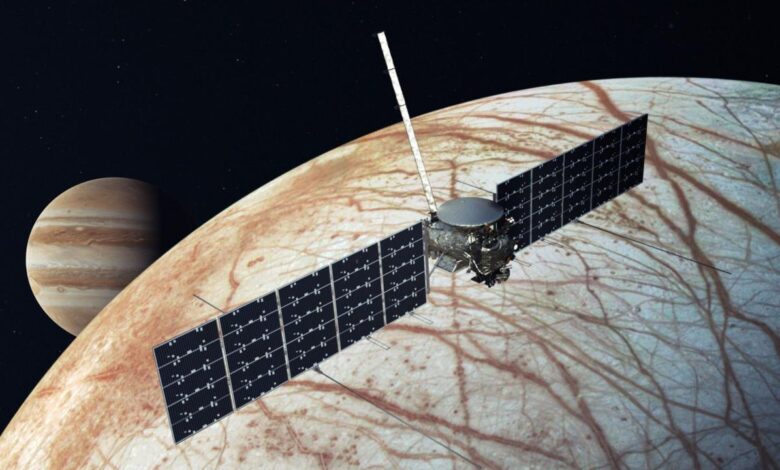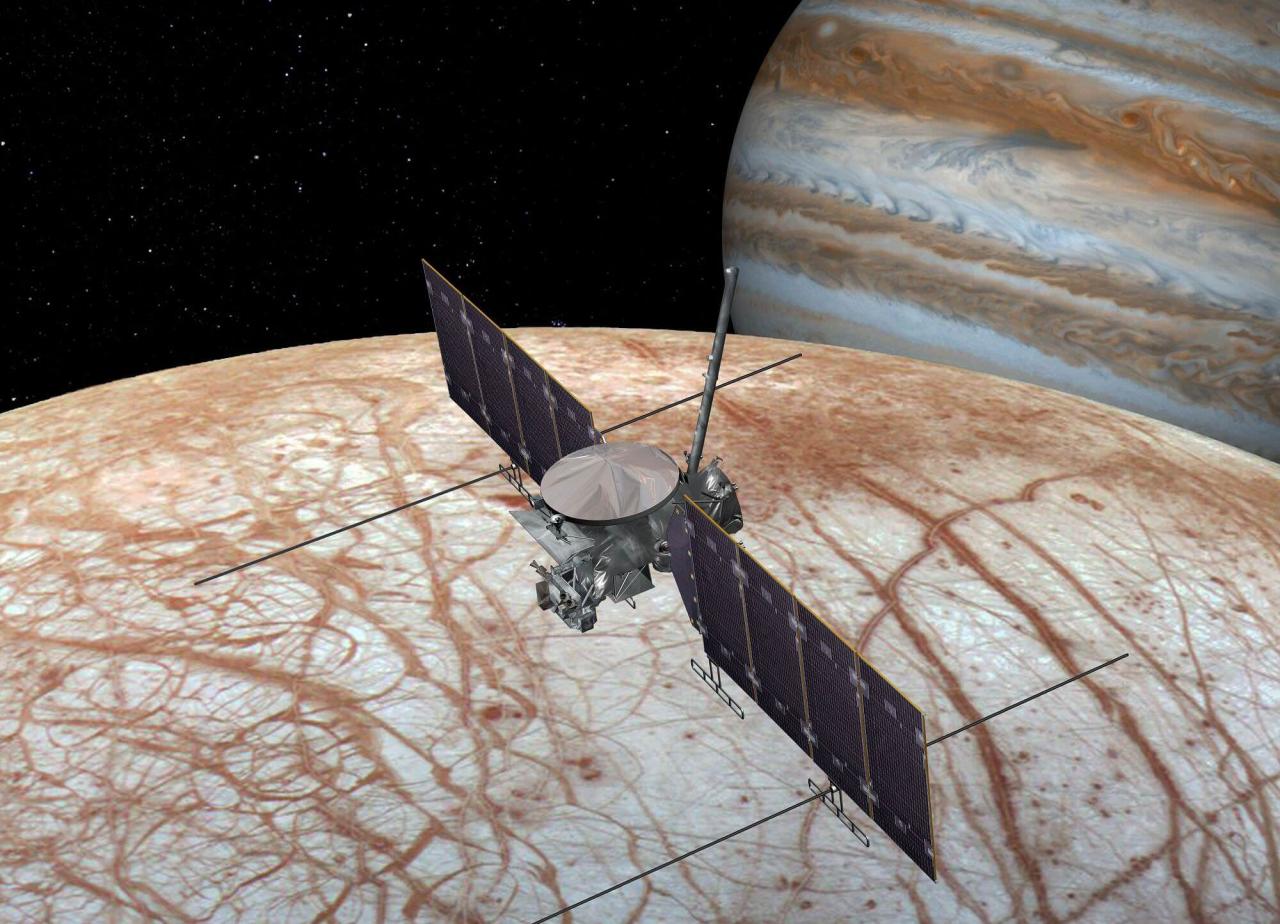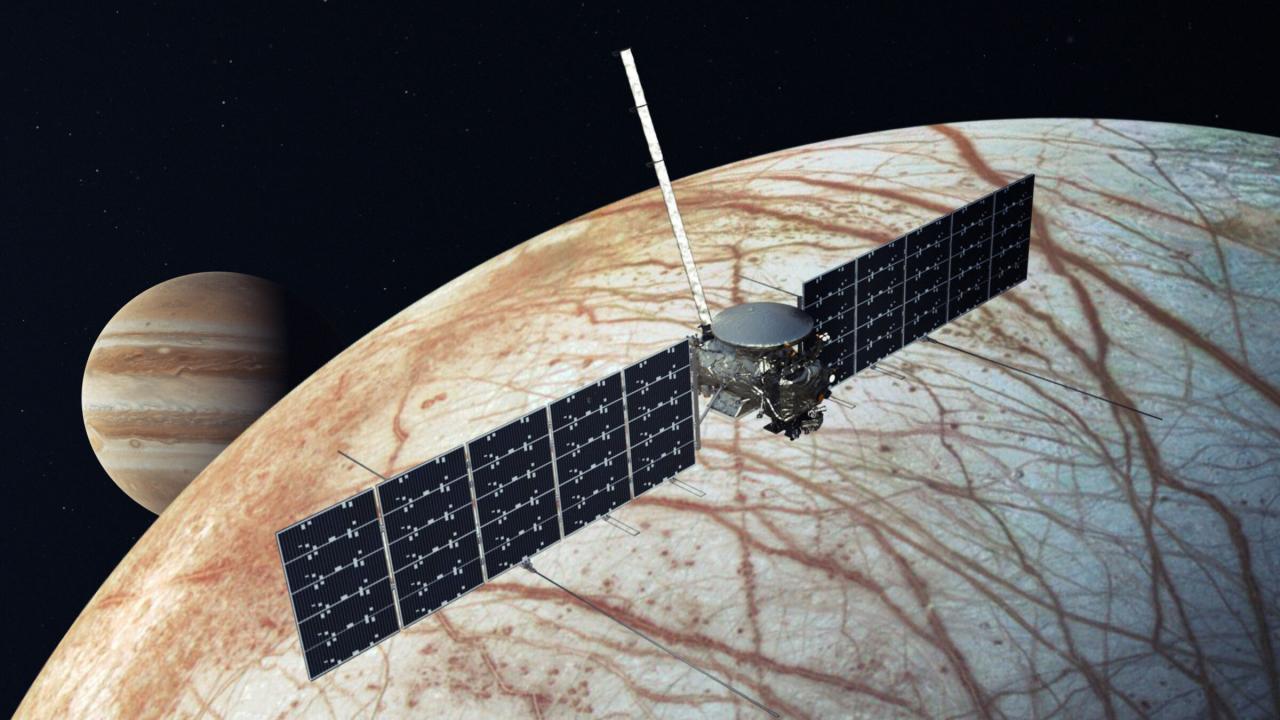
Will Europa Clipper Find Life on Jupiters Moons?
Will europa clipper find signs of life on jupiters icy moons – Will Europa Clipper find signs of life on Jupiter’s icy moons? That’s the burning question driving NASA’s ambitious Europa Clipper mission. This incredible spacecraft is poised to undertake a series of daring flybys of Jupiter’s moon Europa, a world hidden beneath a thick shell of ice, potentially harboring a vast ocean that could hold the key to extraterrestrial life.
The mission’s sophisticated instruments will hunt for biosignatures – telltale signs of past or present life – in this alien ocean, promising to rewrite our understanding of life beyond Earth.
The journey itself is a testament to human ingenuity. Europa Clipper will navigate the intense radiation belts surrounding Jupiter, using a complex trajectory to make repeated close approaches to Europa. Each flyby offers a unique opportunity to gather data, utilizing a suite of cutting-edge instruments designed to peer beneath the icy surface and analyze Europa’s composition, searching for clues about the ocean’s habitability and the possibility of life.
Europa Clipper Mission Overview

The Europa Clipper mission represents a significant leap forward in our quest to understand the potential for life beyond Earth. This ambitious NASA mission is focused on Jupiter’s icy moon, Europa, a world suspected of harboring a vast subsurface ocean that could potentially support life. The mission’s comprehensive suite of instruments aims to characterize Europa’s subsurface ocean, its ice shell, and its surface, searching for evidence of habitability and potential biosignatures.
Primary Scientific Objectives
The primary scientific objectives of the Europa Clipper mission are multifaceted. They include determining the thickness of Europa’s icy shell, characterizing the composition and properties of the subsurface ocean, searching for evidence of plumes erupting from the ocean to the surface, mapping the surface geology and composition, and assessing Europa’s potential for habitability. These objectives are crucial in determining whether Europa possesses the necessary ingredients for life and providing insights into the processes that shape icy moons throughout the solar system.
The data gathered will be instrumental in informing future missions that could potentially search for direct evidence of life.
Spacecraft Instruments and Biosignature Detection
The Europa Clipper spacecraft is equipped with a sophisticated array of nine science instruments designed to investigate Europa’s diverse features. These instruments are capable of performing a wide range of analyses, including high-resolution imaging, spectroscopic measurements, radar sounding, and magnetometry. For example, the MAGEIS (Magnetometer) will measure Europa’s magnetic field to infer the characteristics of the subsurface ocean.
The Europa Clipper mission is super exciting! Will it find evidence of life on Jupiter’s icy moons? That’s the big question. It’s a massive undertaking, almost as complex as the work done by the department of the interior in managing our own planet’s resources. Hopefully, the data from Europa will give us amazing insights into the possibility of life beyond Earth, answering a question that has captivated humanity for ages.
The REASON (Radar for Europa Assessment and Sounding: Ocean to Near-surface) instrument will penetrate the ice shell to determine its thickness and structure. The UVS (Ultraviolet Spectrograph) will search for evidence of plumes emanating from the ocean, and the MASSCAM (Mass Spectrometer) will analyze the composition of any such plumes. These and other instruments will work in concert to identify potential biosignatures, such as organic molecules or evidence of hydrothermal activity.
Mission Trajectory and Europa Flybys
The Europa Clipper mission utilizes a complex gravity-assist trajectory to reach Jupiter and then perform numerous close flybys of Europa. The spacecraft will not orbit Europa directly, but instead will execute a series of close flybys, each offering a unique perspective and opportunity for data collection. This approach allows for a comprehensive survey of Europa’s surface and subsurface, maximizing the scientific return while minimizing the risk of contamination.
Will Europa Clipper find signs of life? It’s a question that keeps me up at night, alongside other mind-boggling possibilities. Thinking about the vastness of space makes me consider the scale of even earthly events, like the recently discovered issue of uncounted votes on overlooked memory card flip election in georgia , which shows how easily things can be overlooked, even on a much smaller scale than the universe.
Ultimately, both scenarios highlight the importance of thorough investigation – whether searching for extraterrestrial life or ensuring fair elections.
These flybys will allow the instruments to gather detailed data at various locations across Europa’s surface, providing a global perspective on the moon’s characteristics. The close flybys are crucial for obtaining high-resolution data and for performing targeted observations of specific regions of interest.
Europa Clipper Mission Summary
| Feature | Details |
|---|---|
| Launch Date | October 28, 2024 |
| Arrival at Jupiter | July 2030 (estimated) |
| Mission Duration | Approximately 5 years at Jupiter |
| Number of Europa Flybys | At least 45 close flybys of Europa |
Europa’s Subsurface Ocean: Will Europa Clipper Find Signs Of Life On Jupiters Icy Moons

Europa, one of Jupiter’s four Galilean moons, captivates scientists with the strong possibility of harboring a vast subsurface ocean. This ocean, hidden beneath a thick icy shell, presents a compelling target in the search for extraterrestrial life, offering a potentially habitable environment far removed from the harsh conditions on the Jovian surface. The evidence for this ocean is compelling and multifaceted, drawing on observations from ground-based telescopes and spacecraft missions.The existence of a subsurface ocean on Europa is supported by a convergence of observational data.
Voyager and Galileo spacecraft missions revealed a surprisingly smooth surface, punctuated by relatively few impact craters compared to other icy moons. This suggests a young, active surface constantly resurfacing itself, a process that could be driven by the movement of water beneath the ice. Furthermore, the detection of a weak magnetic field induced by Jupiter’s magnetic field further strengthens the case for a highly conductive subsurface ocean, likely composed of salty water.
The search for extraterrestrial life is captivating, and the Europa Clipper mission holds immense promise in its hunt for signs of life on Jupiter’s icy moons. It’s a massive undertaking, much like the legal battle unfolding, as reported here: nyc 3 more states file lawsuit against trump rules on immigrants receiving public aid , which highlights the complexities of navigating societal issues on Earth.
Ultimately, both endeavors require significant resources and dedication to achieve their respective goals – uncovering life beyond Earth and ensuring fair treatment for all.
The observed chaotic terrain and evidence of plumes erupting from the surface also point towards subsurface liquid water interacting with the icy shell.
Ocean Characteristics
Estimates suggest Europa’s subsurface ocean may contain twice the amount of water found on Earth’s oceans. The depth is estimated to be anywhere from 60 to 160 kilometers, a significant volume potentially containing a vast range of environments. While the exact salinity remains unknown, it is likely to be significantly higher than Earth’s oceans, possibly containing dissolved salts and minerals from the rocky mantle below.
The ocean’s composition is also a subject of ongoing investigation, with the possibility of dissolved gases and organic molecules contributing to its complexity. The presence of hydrothermal vents, similar to those found on Earth’s ocean floor, is also considered a possibility, potentially providing energy sources that could support life.
Ocean’s Liquid State Maintenance
The persistence of a liquid ocean on Europa, despite its considerable distance from the sun, is a remarkable phenomenon. Tidal forces generated by Jupiter’s immense gravity play a crucial role. The gravitational pull varies as Europa orbits Jupiter, causing significant flexing and tidal heating within the moon’s interior. This process generates heat, counteracting the tendency for the ocean to freeze.
The exact balance between tidal heating and heat loss through the ice shell determines the ocean’s temperature and its liquid state. This mechanism is similar to how the moon Io, closer to Jupiter, experiences intense volcanic activity due to stronger tidal forces.
Europa’s Layered Structure, Will europa clipper find signs of life on jupiters icy moons
The following infographic illustrates the layered structure of Europa:
Imagine a cross-section of Europa. At the top, you see a relatively thin, but highly fractured ice shell, ranging from 10 to 30 kilometers thick. This shell is not uniform; it’s characterized by regions of smooth ice and highly chaotic terrain, suggesting dynamic interactions with the underlying ocean. Beneath the ice lies the vast, global subsurface ocean, potentially reaching depths of over 100 kilometers.
This ocean is thought to be salty and may contain dissolved minerals and gases. Finally, at the very bottom, lies a rocky mantle, possibly composed of silicate rocks and possibly containing a metallic core. The exact composition and structure of the mantle are currently unknown, but its interaction with the ocean is crucial for the ocean’s chemical composition and potential habitability.
Potential Biosignatures and Detection Methods
The Europa Clipper mission aims to not only explore Jupiter’s icy moon Europa but also to search for evidence of past or present life. This search hinges on the detection of biosignatures – chemical or physical indicators that suggest the presence of life. The challenge lies in identifying these subtle signs amidst the harsh radiation environment and the complex chemical makeup of Europa’s surface and subsurface ocean.
The spacecraft will employ a sophisticated suite of instruments to undertake this ambitious task.The detection of biosignatures on Europa relies on a multi-pronged approach, combining remote sensing techniques with potential in-situ analysis (though in-situ analysis is not currently planned for this mission). The sensitivity and limitations of each method vary considerably, depending on the target biosignature and the environment it’s found in.
Understanding these limitations is crucial for interpreting the data collected by the Europa Clipper.
Methods for Detecting Biosignatures
The Europa Clipper will utilize several instruments to search for biosignatures. These include spectrometers to analyze the composition of plumes (if they exist) and the surface, and radar to probe the subsurface ocean. The data gathered by these instruments will be analyzed for evidence of organic molecules, isotopic anomalies, and other indicators of biological activity. The success of these methods depends on several factors, including the abundance and distribution of biosignatures, the resolution of the instruments, and the ability to differentiate between biological and abiological processes.
For example, the detection of certain organic molecules, while suggestive of life, could also result from non-biological processes.
Potential Biosignatures and Detection Techniques
The following list Artikels some key biosignatures and the corresponding detection techniques the Europa Clipper will employ. The detection of these indicators would not definitively prove life exists, but rather would provide compelling evidence warranting further investigation.
- Organic Molecules: Complex organic molecules, such as amino acids or nucleotides, are fundamental building blocks of life. The Europa Clipper’s spectrometers (e.g., the MASPEX instrument) will analyze the composition of plumes or surface materials to identify the presence and abundance of these molecules. The limitations here include the potential for abiogenic (non-biological) organic molecule formation and the ability to distinguish between simple and complex organic molecules.
A high abundance of complex organics would be more suggestive of biological processes.
- Isotopic Anomalies: Life preferentially utilizes certain isotopes of elements (e.g., carbon-12 over carbon-13). Significant deviations from the expected isotopic ratios in Europa’s ocean or surface materials could indicate biological activity. Mass spectrometers, like those on board the Europa Clipper, are capable of making such isotopic measurements. However, geological processes can also lead to isotopic fractionation, making it crucial to carefully interpret the results.
- Oxidants and Reductants: The presence of certain oxidants (e.g., oxygen) and reductants (e.g., hydrogen) in specific ratios could indicate metabolic processes. The detection of these chemicals would require spectroscopic analysis of plumes or surface materials. The challenge here is that these chemicals may also be present due to non-biological processes, requiring careful consideration of the geological context.
- Biologically-Induced Mineralogy: Certain minerals are known to form through biological processes. Spectroscopic analysis of the surface or plumes could identify these minerals. For example, the detection of specific carbonate minerals in unusual abundances or formations could be indicative of biological influence. Again, abiogenic formation of these minerals is possible, necessitating careful analysis and contextual interpretation.
Challenges and Uncertainties
The search for life on Europa, while incredibly exciting, is fraught with significant challenges. The immense distances involved, coupled with the unique and harsh environment of Jupiter’s icy moon, present obstacles that require innovative solutions and careful interpretation of data. Even with the advanced technology of the Europa Clipper, definitively proving the existence of life will be a monumental task.
The most significant hurdle is Europa’s thick ice shell, estimated to be tens of kilometers thick in places. This icy barrier prevents direct access to the subsurface ocean, the prime location for potential life. Furthermore, Europa’s proximity to Jupiter exposes it to intense radiation, which could sterilize the surface and potentially damage any organic molecules present in the ocean.
This radiation poses a challenge not only for the survival of life but also for the instruments attempting to detect it.
Ice Penetration and Radiation Effects
Penetrating the thick ice shell to directly sample the subsurface ocean is a major technological challenge. Current technology doesn’t allow for drilling through such a thick layer of ice in a reasonable timeframe, especially given the distance to Europa. Indirect methods, such as analyzing plumes of water vapor erupting from the surface (if they exist in sufficient quantity and are accessible to the spacecraft) or detecting chemical signatures within the ice itself, are therefore necessary.
The intense radiation also affects the interpretation of data. Radiation can alter the chemical composition of samples, creating false positives or masking true biosignatures. For example, radiation could break down organic molecules, making them harder to detect, or create chemical compounds that mimic the presence of life.
False Positives and Ambiguous Data
The identification of life relies on detecting biosignatures – chemical or physical indicators that suggest the presence of life. However, non-biological processes can also create similar signatures, leading to false positives. For example, hydrothermal vents on the ocean floor could produce chemical gradients similar to those produced by biological activity. Similarly, the geological processes occurring within Europa’s interior could produce chemical compounds that mimic biosignatures.
Differentiating between biological and non-biological sources of these signatures will require extremely careful analysis and cross-validation of data from multiple instruments.
Instrumental Limitations
The Europa Clipper carries a suite of sophisticated instruments, but even these have limitations. For instance, the ability to detect subtle variations in chemical composition or isotopic ratios within the ocean, critical for distinguishing biological from non-biological processes, might be hampered by the distance and the presence of the ice shell. The sensitivity of instruments to detect low concentrations of biosignatures, particularly in a potentially harsh radiation environment, is also a factor.
While the instruments are designed to maximize the chances of detection, a definitive confirmation of life might require a higher level of sensitivity than currently achievable.
Comparison of Approaches to Searching for Life
Different approaches to searching for life on Europa each have advantages and disadvantages. The table below compares some key methods:
| Approach | Advantages | Disadvantages | Data Type |
|---|---|---|---|
| Analyzing plumes | Direct access to subsurface ocean material, relatively easier sampling. | Plume activity may be intermittent or localized, limited sampling volume. Exposure to radiation. | Chemical composition, isotopic ratios. |
| Analyzing ice surface | Access to a wider area, potential for detection of past life. | Deep ice penetration is challenging, radiation damage to surface materials. | Chemical composition, isotopic ratios, trapped organic molecules. |
| Radar sounding | Mapping subsurface ocean depth and structure. | Indirect evidence, cannot directly detect life. | Ice thickness, subsurface ocean properties. |
| Magnetic field measurements | Indirect evidence of subsurface ocean salinity and flow. | Indirect evidence, interpretation can be complex. | Magnetic field variations. |
The Europa Clipper mission represents a giant leap in our quest to answer one of humanity’s most profound questions: Are we alone? While the challenges are immense – from the harsh radiation environment to the difficulty of detecting life from afar – the potential rewards are equally staggering. The data collected by Europa Clipper will not only tell us about Europa, but could reshape our understanding of the prevalence of life in the universe, sparking new avenues of research and inspiring future generations of explorers.
The suspense is palpable as we eagerly await the results of this groundbreaking mission, holding our breath for a potential glimpse into life beyond our pale blue dot.

